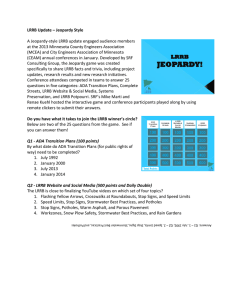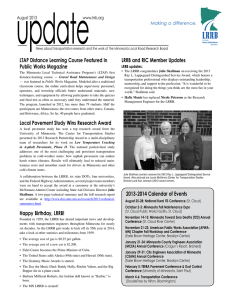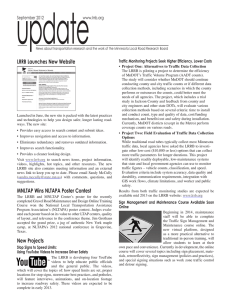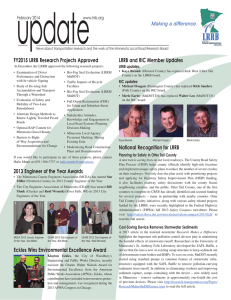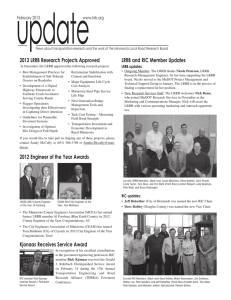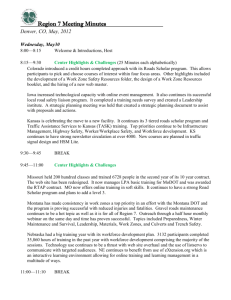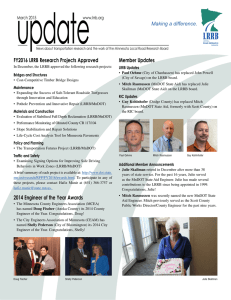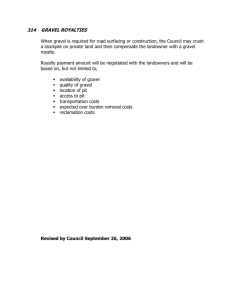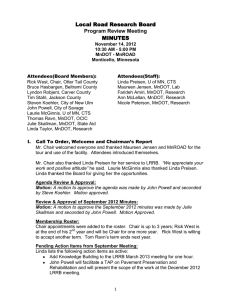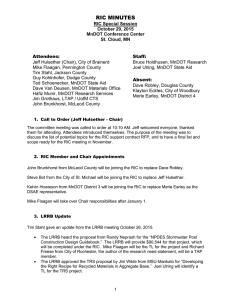update National Recognition for LRRB Making a difference. September 2014
advertisement
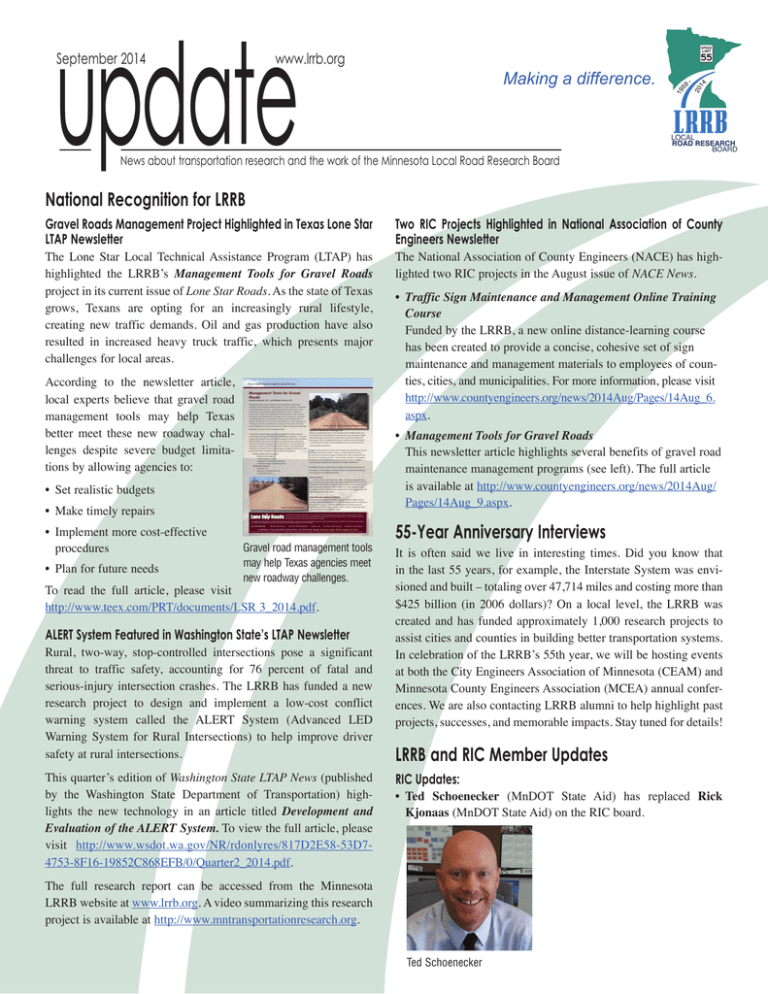
update September 2014 www.lrrb.org Making a difference. News about transportation research and the work of the Minnesota Local Road Research Board National Recognition for LRRB Gravel Roads Management Project Highlighted in Texas Lone Star LTAP Newsletter The Lone Star Local Technical Assistance Program (LTAP) has highlighted the LRRB’s Management Tools for Gravel Roads project in its current issue of Lone Star Roads. As the state of Texas grows, Texans are opting for an increasingly rural lifestyle, creating new traffic demands. Oil and gas production have also resulted in increased heavy truck traffic, which presents major challenges for local areas. According to the newsletter article, local experts believe that gravel road management tools may help Texas better meet these new roadway challenges despite severe budget limitations by allowing agencies to: Texas A&M Engineering Extension Service Management Tools for Gravel Roads Greg Brinkmeyer, P.E., and William Lowery, P.E. Traditionally, gravel road maintenance is scheduled after a quick visual inspection of the roadway’s surface condition, or more commonly, in response to complaints from road users. Sometimes local supervisors know of road sections that will need attention after significant rain events. However, in many areas of Texas more sophisticated methods may be in order, because the need for road maintenance is expanding. As the state grows, Texans are increasingly opting for a rural lifestyle, resulting in new traffic demands. In addition, increases in heavy trucks and other traffic, due to rapid expansion of oil and gas production, present major challenges for local areas. The use of good management tools may hold promise for better meeting these challenges, especially in the face of severe budget limitations. The Minnesota Department of Transportation (MnDOT) has taken a big step toward helping local agencies meet the road maintenance challenge. In a recent Transportation Research Synthesis, commissioned by the Minnesota Local Road Research Board, cities and counties across the nation were surveyed to learn about use of tools for managing gravel road maintenance. Not surprisingly, few jurisdictions use such a road management tool. However, most recognize the value that such a system may have for developing management plans. From those using an information management tool, the following was learned: Primary reasons for use were to: • Manage costs/budgets • Track conditions of roads • Guidance for scheduling maintenance • Information helpful in prioritizing routes Useful data collected: • Materials cost • Manpower and Equipment cost • Construction History Creating an operating plan for gravel road management and organizing to function accordingly, takes time and effort. However, as traffic demands continue to increase and local agencies struggle to maintain their roads, management tools will become increasingly important. These can allow an agency to successfully schedule and correct roadway deficiencies in a proactive manner instead of simply reacting to situations with repeated “just enough” maintenance. Regardless of the type of information tool used, good results will depend on the three steps: 1) initial inventory of roadway conditions; 2) evaluation and rating of road segments; and 3) setting of priorities. Initially, officials must inventory their roads. Since any one road can have varying conditions along its length, roads must be divided into inventory segments having similar characteristics. Segments can be based on general traffic demand, right-of-way width, or any other criteria specific to the road’s character and use. During this inventory, information such as construction history, roadway width, and major drainage features is collected. Gravel Road Evaluation and Rating • Make timely repairs • Plan for future needs Taking an organized approach to road management has multiple benefits. By documenting the actual conditions of roads, agencies can: set realistic budgets; make timely repairs; implement more cost-effective procedures; and plan for future needs. With more detailed information, local officials can better respond to questions from the public, because explanations become easier and tend to receive greater public support. Initial Inventory • Set realistic budgets • Implement more cost-effective procedures Gravel road without crown; poor edge maintenance Benefits Of Maintenance Management Gravel road with good crown Experience informs us that the condition of a gravel road can change, literally overnight. Heavy rains followed by local traffic can change surface characteristics from one day to the next. However, knowledgeable motor grader work can significantly improve the surface. For this reason, surface condition evaluations should not be the primary evaluation criteria. The Local Technical Assistance Program (LTAP) is a nationwide effort financed by the Federal Highway Administration and individual state departments of transportation. Its purpose is to translate into understandable terms the best available technology for roadways, bridges, bicycle and pedestrian facilities, and public transportation for city and county roadway and transportation personnel. The Lone Star LTAP center, operated by the Texas A&M Engineering Extension Service, is sponsored by the Texas Department of Transportation (TxDOT) and the Federal Highway Administration. This newsletter is designed to keep you informed about new publications, techniques, and training opportunities that may be helpful to you and your community. Lone Satr LTAP Staff: Tony Alotto, Program Director Kathy Stone, LTAP Training Manager Guy Benson, Editor Lisa Cumby, Customer Care Center Martha Malone, Graphic Designer For Information: Phone: 800-SAFE-811 (800-723-3811) Fax: 979-458-1426 Website: www.teex.org/ltap E-mail: itsi@teex.tamu.edu It is the policy of the Texas A&M Engineering Extension Service that all federal statutes will be followed pertaining to employment and recruitment of students without regard to race, sex, color, religion, national origin, age, or disability. 2 Lone Star Roads Gravel road management tools may help Texas agencies meet new roadway challenges. To read the full article, please visit http://www.teex.com/PRT/documents/LSR 3_2014.pdf. ALERT System Featured in Washington State’s LTAP Newsletter Rural, two-way, stop-controlled intersections pose a significant threat to traffic safety, accounting for 76 percent of fatal and serious-injury intersection crashes. The LRRB has funded a new research project to design and implement a low-cost conflict warning system called the ALERT System (Advanced LED Warning System for Rural Intersections) to help improve driver safety at rural intersections. This quarter’s edition of Washington State LTAP News (published by the Washington State Department of Transportation) highlights the new technology in an article titled Development and Evaluation of the ALERT System. To view the full article, please visit http://www.wsdot.wa.gov/NR/rdonlyres/817D2E58-53D74753-8F16-19852C868EFB/0/Quarter2_2014.pdf. Two RIC Projects Highlighted in National Association of County Engineers Newsletter The National Association of County Engineers (NACE) has highlighted two RIC projects in the August issue of NACE News. • Traffic Sign Maintenance and Management Online Training Course Funded by the LRRB, a new online distance-learning course has been created to provide a concise, cohesive set of sign maintenance and management materials to employees of counties, cities, and municipalities. For more information, please visit http://www.countyengineers.org/news/2014Aug/Pages/14Aug_6. aspx. • Management Tools for Gravel Roads This newsletter article highlights several benefits of gravel road maintenance management programs (see left). The full article is available at http://www.countyengineers.org/news/2014Aug/ Pages/14Aug_9.aspx. 55-Year Anniversary Interviews It is often said we live in interesting times. Did you know that in the last 55 years, for example, the Interstate System was envisioned and built – totaling over 47,714 miles and costing more than $425 billion (in 2006 dollars)? On a local level, the LRRB was created and has funded approximately 1,000 research projects to assist cities and counties in building better transportation systems. In celebration of the LRRB’s 55th year, we will be hosting events at both the City Engineers Association of Minnesota (CEAM) and Minnesota County Engineers Association (MCEA) annual conferences. We are also contacting LRRB alumni to help highlight past projects, successes, and memorable impacts. Stay tuned for details! LRRB and RIC Member Updates RIC Updates: • Ted Schoenecker (MnDOT State Aid) has replaced Rick Kjonaas (MnDOT State Aid) on the RIC board. The full research report can be accessed from the Minnesota LRRB website at www.lrrb.org. A video summarizing this research project is available at http://www.mntransportationresearch.org. Ted Schoenecker Highlighted LRRB Projects Traffic Sign Life Expectancy Project While local organizations have always been encouraged to maintain their traffic signs, public agencies are now required to implement a sign maintenance/replacement program. But how long do traffic signs really last? To answer this question, the LRRB has funded a new research project to develop expected sign life values, enabling local agencies to better manage their traffic sign assets. As part of the research project, MnDOT researchers have installed a test deck of sample signs at the MnROAD Research Center. A research team will use this test deck to study retroreflectivity (visibility) and color readings over time to eventually determine the life of sign sheeting material. Pedestrian Crossings: Uncontrolled Locations A new guidebook has been developed to help local transportation agencies evaluate their uncontrolled pedestrian crossings and determine appropriate treatment options. Using an 11-step evaluation process, practitioners can identify an appropriate level of treatment for their location, ranging from in-street crossing signs to overhead flashing beacons. For each potential treatment option, the guidebook includes additional information including advantages, disadvantages, recommended locations, and cost. A worksheet based on the methodology presented in the 2010 Highway Capacity Manual was also developed to evaluate the pedestrian level of service (LOS) at uncontrolled crossing locations. For more information and to access the guidebook and worksheets, please visit http://www.mnltap.umn.edu/publications/handbooks/ pedcrossingguide/ or http://www.lrrb.org/media/reports/201421.pdf. 2014 – 2015 Calendar of Events October 8-9: Minnesota Fall Maintenance Expo St. Cloud Public Works Facility, St. Cloud, MN http://mnfallexpo.com/ November 13-14: Minnesota Toward Zero Deaths (TZD) Conference Duluth Entertainment Convention Center, Duluth, MN http://www.minnesotatzd.org/events/conference/2014/index.html November 19-21: American Public Works Association (APWA) MN Chapter Fall Workshop and Conference Earle Brown Heritage Center, Brooklyn Center, MN Researchers will use a test deck of sample signs from around the state to study retroreflectivity and color readings to determine the life of sign sheeting material. For more information regarding traffic sign life expectancy (including recommendations and best policy practices), please visit the following resources: • MnDOT Project Site http://www.dot.state.mn.us/materials/signretroreflectivity.html • LRRB Full Report http://www.lrrb.org/media/reports/201420.pdf • YouTube Video http://youtu.be/f7cDEOu6RMQ http://www.apwa-mn.org/ January 20-23: Minnesota County Engineers Association (MCEA) Annual Conference Cragun’s Resort and Hotel, Brainerd, MN http://www.mncountyengineers.org/ January 28-30: City Engineers Association of Minnesota (CEAM) Annual Conference Earle Brown Heritage Center, Brooklyn Center, MN http://www.ceam.org/ February (TBD): Transportation Engineering and Road Research Alliance (TERRA) Pavement Conference University of Minnesota, Saint Paul, MN http://www.terraroadalliance.org/ March 4-5: Minnesota’s Transportation Conference DoubleTree by Hilton, Bloomington, MN http://mntransportationconference.org/
